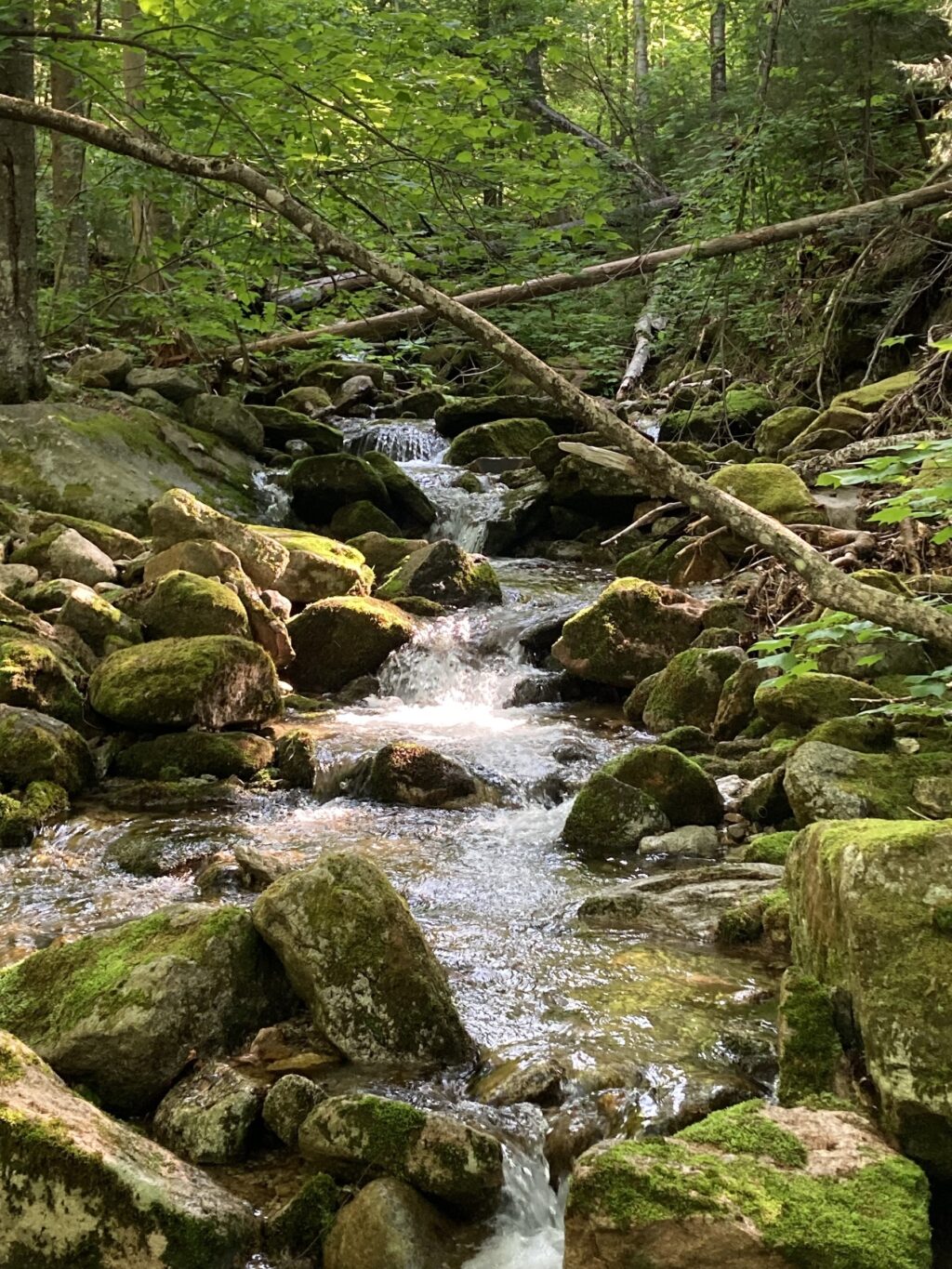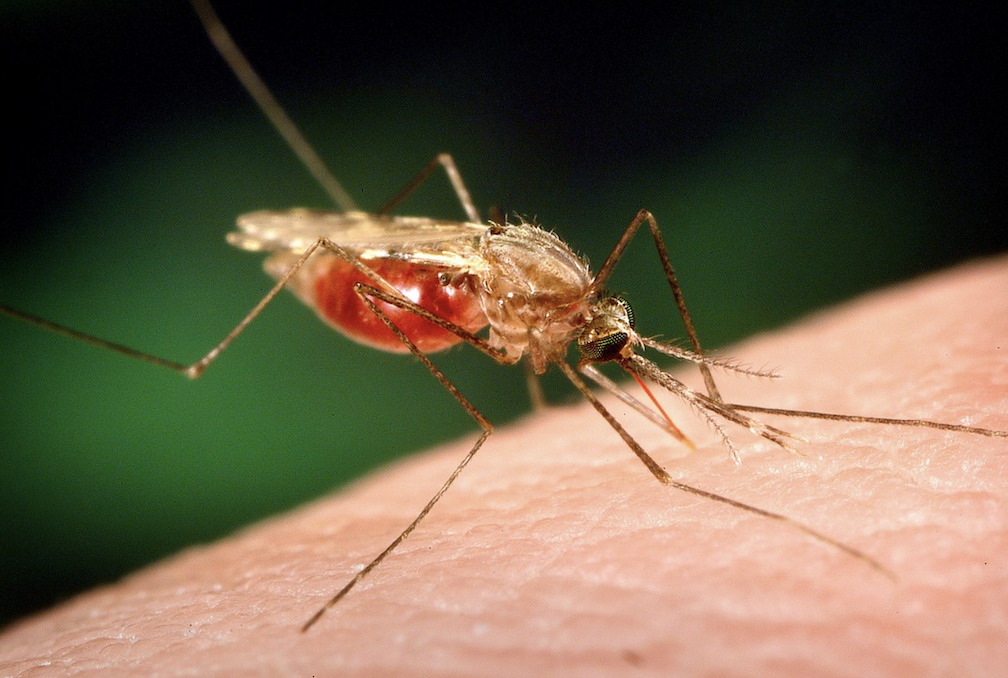Almanac: Anopheles As Mephistopheles

It looks idyllic, but this stream in the White Mountains was the scene of some recent close encounters of the mosquito kind. Photo: Stephen Braun
I don’t know about you, but I have been unusually beset by mosquitos this summer. On a backpacking trip in the White Mountains my companion and I were surprised by clouds of the biting demons not only at dusk, which we expected, but even in the cool mornings. We resorted to our head nets (thank god for head nets!) at breakfast as well as every other meal. In my backyard and around a friend’s house in Hadley the mosquito attacks have been relentless. But it’s not just here in unusually wet New England. Hiking in the Cascades a couple of weeks ago the mosquitos were thicker than I’d ever encountered. Ditto in the Tetons.
I actually have a fairly high tolerance for bugs, in general. For reasons unknown, I am often the last person in a group to be set upon, and I don’t have any allergic reactions to black flies, mosquitos, deer flies, gnats, midges, and other nasties. I don’t like the smell or feel of DEET, so often I just put up with the pests. But I have my limits—and those limits were reached in all of the situations I just described. Happily, DEET works really well, and it allowed me to enjoy some truly wonderful times in mountains that would have been utterly miserable without it.
As much as I don’t like mosquitos, and feel no compunction to killing them, I don’t hate them. They’re just trying to survive, after all, and have no idea of the pain and suffering they can inflict. Knowing more about them helps me (a little bit, anyway) have some compassion for these spawns of Satan, so I thought I’d share a little information in the interest of general enlightenment. (I will note that his Holiness the Dali Lama has admitted that even his renowned compassion for all life is tested—and sometimes bested—by mosquitos.)
At least 52 species of mosquito call Massachusetts home. Not all bite humans, and not all are aggressive. Some prefer to suck the blood of birds, amphibians, or even reptiles. The ones you are most likely to swat are the aptly named Aedes vexans, which are very common and numerous due to their ability to breed several generations each season, and Anopheles quadrimaculatus, which feed on humans and other mammals and readily enter houses. A. quadrimaculatus is named for, and can be identified by, the four dark spots on its wings—but it generally takes an entomologist to identify the different species, not to mention a level of patience for observation that few mortals possess.

Female mosquitos are the ones who bite…although “bite” isn’t really the right word since mosquitos don’t have teeth. Instead, they have a truly impressive and complex set of structures honed by millions of years of natural selection to extract your blood as quickly as possible. The “beak” of a female mosquito isn’t a simple needle of the kind used by human phlebotomists. That tiny stinger-like thing you see is actually a very flexible sheath, within which are six tools: four stiletto-like lances and two tubes. Knife-pointed, toothed, and finer than a hair, the four tiny lancets slice their way rapidly through the skin. They probe around beneath the skin like a questing finger until they find a capillary or other tiny blood vessel. Once a target is found, the female pumps an anticlotting saliva into the wound using one of the tubes. The saliva is what can provoke an allergic response and attendant itching. At the same time, the other tube is used to suck blood up into a chamber in the little lady’s body where fertilized eggs await (mosquitos usually have sex first, then the female goes off in search of blood, which nourishes the eggs).
If she manages to escape your swat, the female will fly to a safe place and rest. It usually takes 4-8 days for the eggs to mature. When they do, the female again takes to the air in search of a bit of still water, where she will lay her eggs. The eggs hatch into “wigglers”—caterpillar-like creatures with a head on one end and a breathing tube at the other. The larvae “swim” by flexing their bodies back and forth like a limber yogi. They feed while they swim, eating bacteria, algae, yeasts, and even tinier aquatic animals. They come to the surface, poke their snorkel out for a breath, then go back down for more.
In a matter of days, assuming they survive (which is a long shot) the larvae stop feeding, remain just under the surface of the water, and develop all of the structures and body parts of an adult. When mature, the adult emerges, pumps up its wings, and flies off. Males immediately start looking for a female by “listening” for the hum of her wings with their antennae and “smelling” using a sophisticated olfactory system involving dozens of specific odor receptors. Males don’t typically live more than a week. The females, with considerably more work to do, live 2-4 weeks.
There’s a lot more that could be said about mosquitos, including the fact that they are a vital food source for many other animals (on the plus side) and that they can also carry and spread some very nasty diseases (on the minus side). But even this cursory sketch of mosquito anatomy and behavior shows how truly amazing these little buggers really are. That they manage so many feats—flying, navigating, feeding, mating—with nothing like a brain and all the required machinery packed into such a tiny package—is really cool. So cool that I’m tempted to model the Dali Lama, who says he sometimes lets a mosquito bite him without swatting it. I get that. Maybe I’ll even try it this evening, out of an honest respect for a fellow creature that is simply another manifestation of the universal life force from which we all emerge. But I’m not a human pincushion and have some rights, as well. So after that first peaceful offering of my blood to one lucky mosquito, watch out!
Almanac is a regular Indy column of observations, musings, and occasional harangues related to the woods, waters, mountains, and skies of the Pioneer Valley. Please feel free to comment on posts and add your own experiences or observations.

I love this essay– the humor mixed with experience and sprinkled with interesting truths about the little buggers I love to hate. Thank you!
Excellent read, Stephen, and thought-provoking. With mosquitos ranked as the world’s deadliest animal, I hope the one you choose to feed is not carrying malaria, EEE, or West Nile Virus. We look forward to many more wonderful Almanac columns!
An image of the Dali Lama being swarmed by these flying phlebotomists is a hard one to shake (but easy to scratch)….